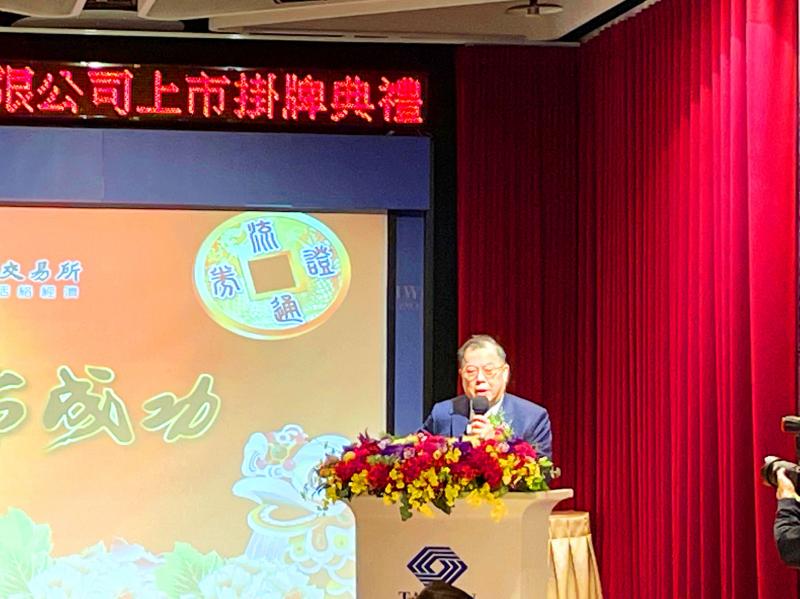Shares of contract chipmaker Powerchip Semiconductor Manufacturing Corp (力積電) yesterday rose by more than 50 percent on its debut on the Taiwan Stock Exchange (TWSE), buoyed by a rosy outlook for the pure-play wafer foundry industry amid tight global supply, dealers said.
Shares of Powerchip Semiconductor closed at NT$75.90, up 52.1 percent from its issuance price of NT$49.90, helping offset the impact on the local market of US market losses on Friday, when the tech-heavy NASDAQ lost 1.92 percent and the Dow Jones Industrial Average declined 0.17 percent due to disappointing US jobs data, dealers said.
Newly listed stock in Taiwan is not restricted by the maximum daily increase or decrease of 10 percent during its first five trading sessions.

Photo: Grace Hung, Taipei Times
Soon after the local equity market opened, Powerchip Semiconductor’s stock price rose 56.31 percent. Its strong showing continued until the end of the session, as investors took their cues from the company’s strong bottom line in the first nine months of this year.
In the first nine months, Powerchip Semiconductor posted a record NT$9.89 billion in net profit, with earnings per share (EPS) of NT$3.07.
Analysts expect its EPS for the whole year to hit NT$4.50 on the back of a robust fourth quarter.
Powerchip Semiconductor generated NT$58.75 billion (US$2.12 billion) in consolidated sales for the first 11 months, up 40.76 percent year-on-year, because the global market did not have enough supply to meet demand.
Powerchip Semiconductor, one of four contract chipmakers in Taiwan, specializes in mature technologies. It owns two 8-inch wafer fabs with a monthly capacity of 110,000 units and three 12-inch wafer plants with a monthly capacity of 110,000 units.
The other three contract chipmakers are Taiwan Semiconductor Manufacturing Co (TSMC, 台積電) — the world’s largest with a share of more than 50 percent of the global market — United Microelectronics Corp (UMC, 聯電) and Vanguard International Semiconductor Corp (世界先進).
Powerchip Semiconductor is the sixth-largest contract chipmaker in the world and the third-largest in Taiwan after TSMC and UMC, company chairman Frank Huang (黃崇仁) said at its initial public offering (IPO) ceremony yesterday.
Huang said he has high hopes that Powerchip Semiconductor will soon become the fifth-largest contract chipmaker in the world, citing orders that the company has secured.
Powerchip Semiconductor’s predecessor was Powerchip Technology Corp (力晶科技), a DRAM supplier that experienced heavy losses in a DRAM cyclical downturn in 2012. Huang was the company’s chief executive officer.
The DRAM maker sold its assets to US-based Micron Technology Inc and delisted from the TWSE in December 2012.
Huang oversaw the restructuring of Powerchip Technology, which transformed into a pure-play wafer foundry business that produced driver ICs for flat panels, imaging processors and power management chips, enabling it to repay its bank loan of NT$120 billion and turn a profit.
Powerchip Technology then spun off its pure-play wafer foundry business, which became Powerchip Semiconductor.
According to the contract chipmaker, its major clients have rushed to sign long-term contracts to secure supplies and deflect the impact of the current supply shortage.
The TWSE said that Powerchip Semiconductor’s robust showing resulted in its market capitalization hitting NT$258.82 billion, the highest figure among all firms that have launched an IPO on the main board in the past three years.
Through the IPO, the company has raised enough to build its planned NT$100 billion plant in Miaoli County, Huang said.

SEMICONDUCTOR SERVICES: A company executive said that Taiwanese firms must think about how to participate in global supply chains and lift their competitiveness Taiwan Semiconductor Manufacturing Co (TSMC, 台積電) yesterday said it expects to launch its first multifunctional service center in Pingtung County in the middle of 2027, in a bid to foster a resilient high-tech facility construction ecosystem. TSMC broached the idea of creating a center two or three years ago when it started building new manufacturing capacity in the US and Japan, the company said. The center, dubbed an “ecosystem park,” would assist local manufacturing facility construction partners to upgrade their capabilities and secure more deals from other global chipmakers such as Intel Corp, Micron Technology Inc and Infineon Technologies AG, TSMC said. It

EXPORT GROWTH: The AI boom has shortened chip cycles to just one year, putting pressure on chipmakers to accelerate development and expand packaging capacity Developing a localized supply chain for advanced packaging equipment is critical for keeping pace with customers’ increasingly shrinking time-to-market cycles for new artificial intelligence (AI) chips, Taiwan Semiconductor Manufacturing Co (TSMC, 台積電) said yesterday. Spurred on by the AI revolution, customers are accelerating product upgrades to nearly every year, compared with the two to three-year development cadence in the past, TSMC vice president of advanced packaging technology and service Jun He (何軍) said at a 3D IC Global Summit organized by SEMI in Taipei. These shortened cycles put heavy pressure on chipmakers, as the entire process — from chip design to mass

People walk past advertising for a Syensqo chip at the Semicon Taiwan exhibition in Taipei yesterday.

NO BREAKTHROUGH? More substantial ‘deliverables,’ such as tariff reductions, would likely be saved for a meeting between Trump and Xi later this year, a trade expert said China launched two probes targeting the US semiconductor sector on Saturday ahead of talks between the two nations in Spain this week on trade, national security and the ownership of social media platform TikTok. China’s Ministry of Commerce announced an anti-dumping investigation into certain analog integrated circuits (ICs) imported from the US. The investigation is to target some commodity interface ICs and gate driver ICs, which are commonly made by US companies such as Texas Instruments Inc and ON Semiconductor Corp. The ministry also announced an anti-discrimination probe into US measures against China’s chip sector. US measures such as export curbs and tariffs